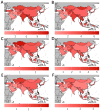The Burden and Trends of Gynecological Cancers in Asia from 1980 to 2021, with Projections to 2050: A Systematic Analysis for the Global Burden of Disease Study 2021
- PMID: 40558241
- PMCID: PMC12191526
- DOI: 10.3390/curroncol32060298
The Burden and Trends of Gynecological Cancers in Asia from 1980 to 2021, with Projections to 2050: A Systematic Analysis for the Global Burden of Disease Study 2021
Abstract
Gynecological cancers pose a significant threat to women's health. This study aimed to investigate the disease burden of cervical, uterine, and ovarian cancers in Asia from 1980 to 2021. The Global Burden of Disease 2021 database (GBD 2021) was used to conduct a cross-sectional study. The incidence, mortality rates, and disability-adjusted life years (DALYs) were obtained as indicators to estimate the burden. The effects of age, period, and cohort on the incidence of gynecological cancers were analyzed via the age-period-cohort web tool (APC-Web). The future trends of the gynecological cancer burden in Asia from 2025 to 2050 were predicted via a Bayesian age-period-cohort model. In 2021, cervical cancer exhibited the highest age-standardized mortality burden (3.1 deaths per 100,000; 95% UI: 2.7-3.4), whereas uterine cancer had the lowest (0.7 deaths per 100,000; 95% UI: 0.6-0.9). Geographically, South Asia has experienced the highest cervical cancer burden, with Seychelles, Mongolia, Cambodia, and Nepal ranking among the most affected nations. In contrast, Central Asia had the highest ovarian cancer burden, led by Georgia, followed by the United Arab Emirates, Seychelles, and Brunei Darussalam. Similarly, the uterine cancer burden was most pronounced in Central Asia, with Georgia, Armenia, Mauritius, and the United Arab Emirates exhibiting elevated rates. Finally, increasing trends in the burden of gynecological cancers were predicted across all age groups from 2025 to 2050, with women aged 60 to 64 years being the most affected. In conclusion, gynecological cancers are significant contributors to the disease burden in Asia. Improved early screening methods are essential to mitigate this increasing burden.
Keywords: Asia; cervical cancer; disease burden; gynecological cancers; ovarian cancer; uterine cancer.
Conflict of interest statement
The authors declare no conflicts of interest.
Figures





Similar articles
-
Mortality of Three Major Gynecological Cancers in the European Region: An Age-Period-Cohort Analysis from 1992 to 2021 and Predictions in a 25‑Year Period.Ann Glob Health. 2025 Jun 10;91(1):30. doi: 10.5334/aogh.4688. eCollection 2025. Ann Glob Health. 2025. PMID: 40528926 Free PMC article.
-
Burden of knee osteoarthritis in China and globally: 1990-2045.BMC Musculoskelet Disord. 2025 Jul 1;26(1):582. doi: 10.1186/s12891-025-08858-8. BMC Musculoskelet Disord. 2025. PMID: 40598022 Free PMC article.
-
Global, regional, and national trends in the epidemiology of aortic aneurysms among women of childbearing age, 1990-2021, with predictions through 2036.BMC Public Health. 2025 Jul 2;25(1):2224. doi: 10.1186/s12889-025-23502-9. BMC Public Health. 2025. PMID: 40604749 Free PMC article.
-
Experiences of gynecological cancer patients receiving care from specialist nurses: a qualitative systematic review.JBI Database System Rev Implement Rep. 2017 Aug;15(8):2087-2112. doi: 10.11124/JBISRIR-2016-003126. JBI Database System Rev Implement Rep. 2017. PMID: 28800057
-
A rapid and systematic review of the clinical effectiveness and cost-effectiveness of paclitaxel, docetaxel, gemcitabine and vinorelbine in non-small-cell lung cancer.Health Technol Assess. 2001;5(32):1-195. doi: 10.3310/hta5320. Health Technol Assess. 2001. PMID: 12065068
References
-
- The Regional Committee for the Western Pacific Cervical Cancer. 2022. [(accessed on 22 February 2025)]. Available online: https://apps.who.int/iris/bitstream/handle/10665/365111/WPR-RC073-Res04-....
-
- Zhang S., Cheng C., Lin Z., Xiao L., Su X., Zheng L., Mu Y., Liao M., Ouyang R., Li W., et al. The global burden and associated factors of ovarian cancer in 1990–2019: Findings from the Global Burden of Disease Study 2019. BMC Public Health. 2022;22:1455. doi: 10.1186/s12889-022-13861-y. - DOI - PMC - PubMed
-
- Garland S., Park S.N., Ngan H.Y., Frazer I., Tay E.H., Chen C.J., Bhatla N., Pitts M., Shin H.R., Konno R., et al. The need for public education on HPV and cervical cancer prevention in Asia. Opinions of experts at the AOGIN conference. Vaccine. 2008;26:5435–5440. doi: 10.1016/j.vaccine.2008.07.077. - DOI - PubMed
MeSH terms
Grants and funding
LinkOut - more resources
Full Text Sources

